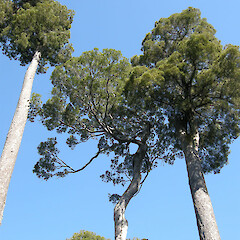Dacrycarpus dacrydioides
Common name
kahikatea, white pine
Synonyms
Dacrydium excelsum D.Don in Lamb., Dacrydium ferrugineum Houttee ex Gord., Dacrydium thuioides Banks et Solander ex Carr., Nageia excelsa Kuntze, Podocarpus dacrydioides Richard, Podocarpus thujoides R.Br. In Bennett, Podocarpus excelsus (D.Don) Druce; Podocarpus excelsus (D. Don.) Druce
Family
Podocarpaceae
Flora category
Vascular – Native
Endemic taxon
Yes
Endemic genus
No
Endemic family
No
Structural class
Trees & Shrubs - Gymnosperms
NVS code
The National Vegetation Survey (NVS) Databank is a physical archive and electronic databank containing records of over 94,000 vegetation survey plots - including data from over 19,000 permanent plots. NVS maintains a standard set of species code abbreviations that correspond to standard scientific plant names from the Ngä Tipu o Aotearoa - New Zealand Plants database.
DACDAC
Chromosome number
2n = 20
Current conservation status
The conservation status of all known New Zealand vascular plant taxa at the rank of species and below were reassessed in 2017 using the New Zealand Threat Classification System (NZTCS) – more information about this can be found on the NZTCS website. This report includes a statistical summary and brief notes on changes since 2012 and replaces all previous NZTCS lists for vascular plants.
Please note, threat classifications are often suggested by authors when publications fall between NZTCS assessment periods – an interim threat classification status has not been assessed by the NZTCS panel.
- Conservation status of New Zealand indigenous vascular plants, 2017 . 2018. Peter J. de Lange, Jeremy R. Rolfe, John W. Barkla, Shannel P. Courtney, Paul D. Champion, Leon R. Perrie, Sarah M. Beadel, Kerry A. Ford, Ilse Breitwieser, Ines Schönberger, Rowan Hindmarsh-Walls, Peter B. Heenan and Kate Ladley. Department of Conservation. Source: NZTCS and licensed by DOC for reuse under the Creative Commons Attribution 4.0 International licence.
2017 | Not Threatened
Previous conservation statuses
2012 | Not Threatened
2009 | Not Threatened
2004 | Not Threatened
Distribution
Endemic. North Island, South Island and Stewart Island/Rakiura.
Habitat
Lowland forest, formerly dominant on frequently flooded, and/or poorly drained alluvial soils. Occasionally extends into lower montane forest. Once the dominant tree of a distinct swamp forest type all but extinct in the North Island—the best examples remain on the West Coast of the South Island.
Wetland plant indicator status rating
Information derived from the revised national wetland plant list prepared to assist councils in delineating and monitoring wetlands (Clarkson et al., 2021 Manaaki Whenua – Landcare Research Contract Report LC3975 for Hawke’s Bay Regional Council). The national plant list categorises plants by the extent to which they are found in wetlands and not ‘drylands’. The indicator status ratings are OBL (obligate wetland), FACW (facultative wetland), FAC (facultative), FACU (facultative upland), and UPL (obligate upland). If you have suggestions for the Wetland Indicator Status Rating, please contact: [Enable JavaScript to view protected content]
FAC: Facultative
Commonly occurs as either a hydrophyte or non-hydrophyte (non-wetlands).
Detailed description
Stout, dioecious, cohort-forming conifer, 50–(65) m tall. Trunk 1–(2) m diam., often fluted and buttressed. Bark grey to dark-grey, falling in thick, sinuous flakes. Wood white, odourless. Trunks bare for ¾ of length, subadults with a distinctive columnar growth habit, branches arising from ⅓–½ trunk length. Branchlets slender, drooping. Leaves of juveniles subdistichous, subpatent, narrow-linear, subfalcate, acuminate, decurrent, 3–7 × 0.5–1mm red, wine-red, dark-green to green; of subadults less than or equal to 4 mm., dark green or red; those of adults 1–2 mm., imbricating, appressed, keel, subtrigonous, lanceolate-subulate to acuminate with broader base, brown-green or glaucous. Male cones terminal, oblong, 10 mm. Pollen pale yellow. Ovule, terminal, solitary glaucescent. Receptacle fleshy, oblong, compressed, warty, 2.5–6.5 mm, yellow to orange-red. Seed broadly obovate to circular (4)–4.5–6 mm diam., purple-black, thickly covered in glaucous bloom.
Similar taxa
A distinctive tree of usually swampy alluvial terraces. The columnar growth form of subadults, buttressed and fluted trunk bases, scale-like leaves, and terminal fruits bearing the distinctive circular seeds serve to immediately distinguish this species from all other indigenous conifers.
Flowering
October–January
Flower colours
No flowers
Fruiting
February–April
Propagation technique
Easily grown from fresh seed. Can be grown from hard-wood cuttings but rather slow to strike.
Threats
Not Threatened, although as a forest-type it has been greatly reduced through widespread logging. Very few intact examples of kahikatea-dominated forest remain in the North Island.
Etymology
dacrycarpus: Tear shaped fruit
dacrydioides: Like a dacrydium
Where To Buy
Commonly cultivated and frequently sold by most commercial nurseries and outlets. A very popular garden tree. A form with distinctly glaucous foliage is occasionally on offer.
Cultural Use/Importance
Kahikatea is New Zealand’s tallest indigenous tree. The white odourless timber was used extensively to make butter boxes, for much of the late 1800s and early 1900s. It was this practice that all but eliminated kahikatea-dominated swamp forest from the North Island and northern South Island.
Attribution
Fact Sheet prepared for NZPCN by P.J. de Lange 12 January 2004: Description adapted from Allan (1961).
References and further reading
Allan HH. 1961. Flora of New Zealand, Volume I. Indigenous Tracheophyta: Psilopsida, Lycopsida, Filicopsida, Gymnospermae, Dicotyledones. Government Printer, Wellington, NZ. 1085 p.
Gardner R. 2001. Notes towards an excursion Flora. Rimu and kahikatea (Podocarpaceae). Auckland Botanical Society Journal 56: 74–75.
NZPCN Fact Sheet citation
Please cite as: de Lange, P.J. (Year at time of access): Dacrycarpus dacrydioides Fact Sheet (content continuously updated). New Zealand Plant Conservation Network. https://www.nzpcn.org.nz/flora/species/dacrycarpus-dacrydioides/ (Date website was queried)




































